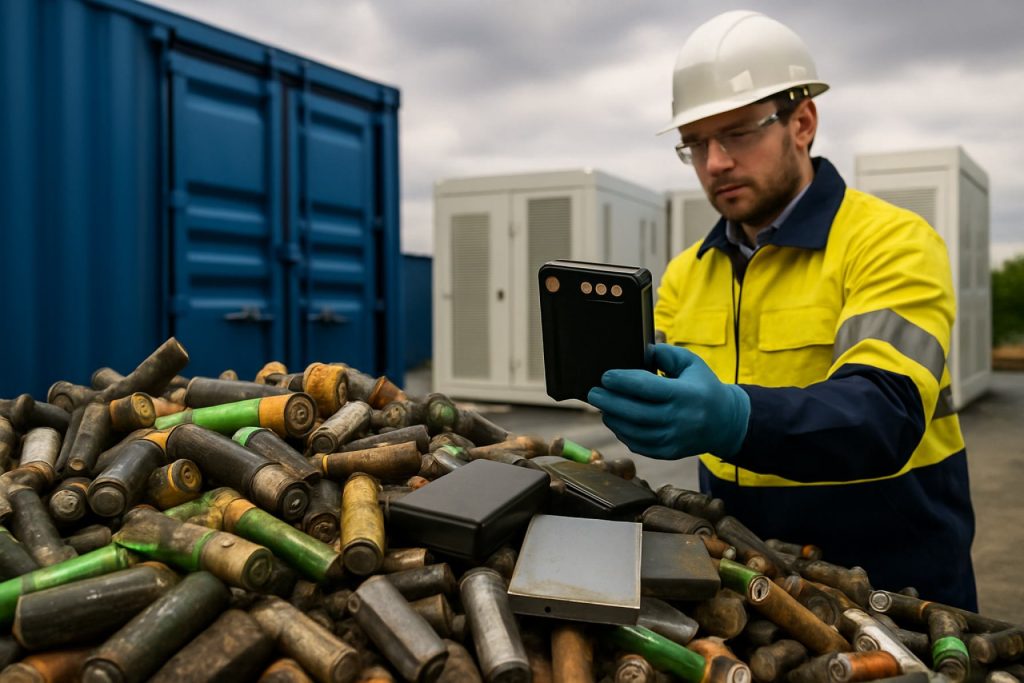
- Battery recycling is transforming from an eco-friendly option into a strategic priority, driving economic growth, resource independence, and national security.
- The Asia-Pacific region leads the market, fueled by strict regulations and investments, especially in China, Japan, South Korea, Australia, and India.
- Europe and North America are advancing with tough laws and innovative recycling technologies, boosting domestic supply of critical minerals like lithium, cobalt, and nickel.
- Emerging regions in Latin America, the Middle East, and Africa are building the groundwork for circular economies and increased local value from battery materials.
- Major players are investing in AI, robotics, and advanced processing to increase efficiency and metal recovery, despite high entry costs and technical hurdles.
- Consumers and businesses play crucial roles by safely returning used batteries and choosing products with recycled content—driving a global shift toward sustainability.
Picture sleek electric cars streaming onto roads, smartphone screens glowing round the clock, and entire cities flickering awake every night. Lurking behind this current of modern convenience are mountains of exhausted batteries—once destined for landfill, now the secret key to a revolution.
Battery recycling has leaped from environmental nicety to the core of global industrial strategy. The market, poised to soar from $22.75 billion today to $41.66 billion by 2030, is not just meeting green goals. It’s fueling new age energy independence, national security, and an economic power shift. Every depleted battery, stripped of its last volt, is now a prize in a fierce contest unfolding across continents.
Asia-Pacific: The Relentless Engine
From the bustling factories of China to the high-tech frontlines of Japan and South Korea, the Asia-Pacific region dominates, generating more than half of worldwide revenue. Ruthless government mandates and game-changing subsidies haven’t just created a recycling network—they’ve built a battery ecosystem in perpetual motion. China’s regulatory crackdown ensures automakers reclaim spent cells, transforming end-of-life batteries into essential raw materials: lithium, cobalt, nickel.
Not far behind, Australia is ascending rapidly, thanks to rich mineral reserves and plants capable of high-purity refining. Here, the future isn’t just in mining; it’s in perfecting the art of molecular-level reclamation. India, meanwhile, has revolutionized waste handling with strict producer-responsibility laws, holding businesses to account for every battery they introduce into the market.
Europe and North America: Rules Spark Innovation
No region comes close to the European Union when it comes to tough recycling standards. New regulations force companies to hit minimum recycling rates, compelling billions in investment for cutting-edge “gigafactories” committed to closing the material loop. In North America, environmental regulations combine with innovation; the U.S. and Canada are pouring resources into cleaner methods like hydrometallurgy and developing direct-recycling frameworks that recover up to 95% of precious metals.
This isn’t just about green credibility. As supply chains buckle under geopolitical pressures, battery recycling ensures that critical minerals—once predominantly sourced from a handful of countries—are domestically available. For consumers and companies alike, it means more stable prices and less vulnerability to global shocks.
Emerging Frontlines: Latin America, Middle East & Africa
Though smaller by volume, these regions are laying the groundwork for the future. Rich mineral deposits and growing investments in recycling hint at a world where raw material control is more fairly distributed—and where circular economies bolster both the environment and local industry.
Tech Turbulence and Global Alliances
The competition for battery scrap is heating up. Giants like Umicore, Glencore, and Redwood Materials are snapping up deals with automakers and electronics firms to guarantee a steady stream of used batteries. Multi-million-dollar mergers and acquisitions are accelerating as companies chase greater control over the vital metals powering the next generation of technology.
But hurdles remain. Setting up even modest recycling operations can cost hundreds of thousands, rising rapidly with scale and the need for advanced equipment and safety precautions. Add in the technical gymnastics of dismantling batteries built to withstand anything but easy disassembly, and the challenge is clear—success hinges on relentless innovation.
Modern plants now deploy artificial intelligence for sorting, robotics for safe handling, and advanced hydrometallurgical formulas that fetch more value with less waste. The bar keeps rising—whoever adapts quickest, wins.
How the Cycle Closes—and Why It Matters
A new generation of companies is designing products for “reuse first”—extending battery life in grid storage or second-life applications before total recycling. Volkswagen is pioneering closed-loop systems in Europe. Redwood Materials in the U.S. and Umicore in Belgium are shrinking carbon footprints by returning recycled metals directly to manufacturers.
Consumers have their part: depositing used batteries at certified collection points, following safe storage protocols, and supporting companies invested in ethical recycling. Businesses—large and small—are discovering that buying products with recycled content is both an eco and strategic imperative.
Not Just a Trend—A Turning Point
Every time a phone is charged or a car is driven, the outcome is being rewritten. The true value of battery recycling is more than pollution prevention—it’s about economic resilience, strategic independence, and the audacious idea that waste can be the foundation of wealth.
As the race intensifies, those who seize opportunity from yesterday’s discarded technology will define the pace of tomorrow’s transformation. To find out more about global innovation trends and what it means for you, visit Bloomberg or learn about sustainable business breakthroughs at Reuters.
Key Takeaway: The world is reimagining waste as a premium resource. Behind every recycled battery lies a safer, greener, and more prosperous future—for those bold enough to chase it.
The Battery Recycling Revolution: Hidden Secrets, Expert Life Hacks, & the Global Power Shift Shaping Our Future
Battery Recycling Market: What the Future Holds & How You Can Join the Circular Economy
Battery recycling is not just a buzzword—it’s the engine behind the clean energy race, electric vehicle surge, and a digital world hungry for sustainable solutions. But behind the headlines, there’s a fast-changing web of cutting-edge tech, billion-dollar investments, and political strategies that will influence how we drive, power our devices, and secure our energy—possibly for decades to come.
What Is Battery Recycling and Why Is It Exploding Now?
Battery recycling refers to recovering valuable materials—like lithium, cobalt, and nickel—from used batteries to produce new ones, dramatically slashing waste and environmental toll. According to the Bloomberg and multiple credible market analyses, the sector is projected to leap from $22.75 billion to $41.66 billion by 2030. That’s an 83% increase—outstripping growth in many other sustainability-related markets.
Critical Tech and Innovations You Didn’t Hear About
- Direct Recycling Innovations: Emerging technologies like direct cathode recycling (developed by scientists at Oak Ridge National Laboratory) can recover battery components without full decomposition, preserving more value and reducing energy use (see U.S. Department of Energy).
- AI-powered Robots for Battery Dismantling: European startups like Duesenfeld and U.S. companies such as Li-Cycle deploy advanced robotics and machine learning to safely sort, dismantle, and extract materials, minimizing human risk (IEA, 2023).
- Second-life Applications: Used EV batteries are increasingly deployed in grid storage, backup energy for buildings, and off-grid solutions—doubling their productive lifespan before final recycling.
- Closed-Loop Manufacturing: Companies like Volkswagen and Umicore now create circular supply chains, keeping recycled materials within their manufacturing ecosystem to cut emissions and costs.
Pros & Cons: Behind the Battery Recycling Boom
| Pros | Cons |
|---|---|
|
|
How-To: Maximize Battery Recycling in Daily Life
- Use Designated Recycling Points: Always return batteries to certified drop-off locations (most electronics retailers and municipal centers participate).
- Store Safely: For lithium-ion batteries, tape the terminals and keep in a cool, dry place. Don’t puncture or burn!
- Avoid E-waste Trash Bins: Batteries thrown in regular garbage pose fire risks and environmental hazards.
- Buy Products with Recycled Content: Many brands now advertise recycled battery materials in their electronics and EVs.
Market Forecast: How Big Could Battery Recycling Get?
- The global battery recycling market could hit $44 billion by 2031 (Allied Market Research).
- Asia-Pacific will likely exceed 60% market share by 2030, with China dominating collection, processing, and raw material exports.
- Europe’s tough new battery regulations (2023/2024) will generate at least ten new gigafactories focused on recycling, according to Reuters.
- EV adoption will drive upping recycling, as by 2030, over 11 million tons of EV batteries could be at end-of-life worldwide (IEA forecast).
Top Players & Tech Specs in Battery Recycling
- Umicore (Belgium): Global recycling leader using proprietary hydrometallurgical tech.
- Li-Cycle (Canada): “Spoke & Hub” tech recycles up to 95% of critical battery materials.
- Redwood Materials (USA): Founded by Tesla’s ex-CTO, recycles EV batteries directly back into new cell production.
- Glencore (Switzerland): Mining and recycling metals with global strategic partnerships.
Technical Note: Most modern processes recover lithium, cobalt, nickel, copper, aluminum, and sometimes even graphite. Hydrometallurgy is safer and less polluting compared to pyrometallurgy, but requires advanced chemical handling systems.
Controversies & Limitations: The Challenges Walling Off Progress
- Design-for-Recycling Gaps: Many rechargeable batteries (especially in small devices) are built for longevity, not easy recycling or disassembly.
- Environmental Debates: Some smelting-based recycling processes still emit toxic compounds—hydrometallurgy is cleaner, but not universal.
- Ethical Collection: Most regions lack robust systems for gathering e-waste from homes and businesses—millions of used batteries still land in landfill or get incinerated.
Security, Sustainability & Market Impact
- National Security: Major economies now treat battery recycling as a security priority to limit dependence on unstable mining regions (U.S. Department of Energy, European Commission).
- Climate Change: Battery recycling reduces the need for carbon-intensive mining and refines rare metals with up to 70% less CO₂ emission (Umicore 2022 Report).
- Sustainable Supply Chains: Closed-loop systems keep metals in the economy, extending resource lifespans for decades.
Pressing Reader Questions: Answered
Q: Can batteries be recycled indefinitely?
A: Most metals from batteries (like cobalt, nickel, and lithium) can be recycled many times without significant quality loss, though technical improvements are ongoing for 100% material recovery.
Q: Is recycled material as good as newly mined minerals?
A: Yes. Battery-grade materials made from recycled sources are chemically equivalent to virgin materials, meeting EV and electronics standards.
Q: Will battery recycling make electric vehicles cheaper?
A: Over time, yes. As more materials are recovered and supply risk falls, battery costs could become more stable—and possibly decline.
Q: Where can I recycle used batteries?
A: Major electronics and automotive stores, municipal waste stations, and certified e-waste centers. Check your country’s e-waste portal for exact drop-off sites.
Expert Recommendations & Quick Tips for Sustainable Tech Users
- Look for “battery recycling” or “second-life battery” labeling when buying electronics and vehicles.
- Support brands with public commitments to using recycled material—examples include Apple, Volkswagen, and Dell.
- Never store large lithium batteries in hot, damp places—risk of fire or leakage increases dramatically.
- Stay updated: Laws and recycling tech are advancing quickly. Seek news on circular economy from sites like Bloomberg or Reuters.
Conclusion: Own a Piece of the Battery Revolution
Battery recycling stands at the crossroads of environmental protection, strategic security, and lucrative new value chains. With technology, regulation, and public awareness racing ahead, now is the perfect moment to become a more conscious battery user—and help spark the next era of sustainable power. Don’t let your used batteries go to waste: recycle smart, buy green, and support the innovators reshaping the world’s energy future.



